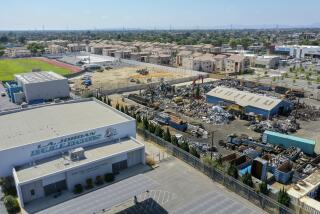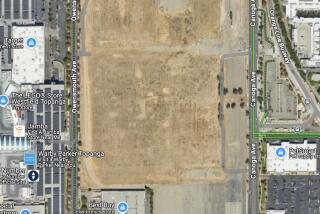Study Says Lab Meltdown Caused Cancer
Radioactive emissions from a 1959 nuclear accident at a research lab near Simi Valley appear to have been much greater than previously suspected and could have resulted in hundreds of cancers in surrounding communities, according to a study released Thursday.
Chemical contamination from rocket engine testing at the site continues to threaten soil and groundwater in the area around Rocketdyne’s Santa Susana Field Laboratory, the study also found.
For the record:
12:00 a.m. Oct. 7, 2006 For The Record
Los Angeles Times Saturday October 07, 2006 Home Edition Main News Part A Page 2 National Desk 1 inches; 45 words Type of Material: Correction
Rocketdyne: An article in Friday’s Section A about Boeing’s Santa Susana Field Laboratory identified Dan Hirsch, co-chairman of a panel overseeing health and environmental studies at the former nuclear testing site, as a physicist. Hirsch is a lecturer on nuclear policy at UC Santa Cruz.
The nuclear meltdown, which remained virtually unknown to the public until 1979, could have caused between 260 and 1,800 cases of cancer “over a period of many decades,” the study concluded.
But the advisory panel that oversaw the five-year study, conducted by an independent team of scientists and health experts, said it could not offer more specifics about potential exposure to carcinogens because the Department of Energy and Rocketdyne’s owner, Boeing Co., did not provide key information.
“This lack of candor ... makes characterization of the potential health impacts of past accidents and releases extremely difficult,” the panel concluded.
Boeing officials vigorously disputed the findings, saying the study was based on miscalculations and faulty information.
“We disagree entirely with the report’s conclusion,” said Phil Rutherford, a health, safety and radiation manager for the company. He cited a Boeing-commissioned study released last year that found overall cancer deaths among employees at the field lab and at Canoga Park facilities between 1949 and 1999 were lower than in the general population.
The Boeing report contradicted findings from an earlier UCLA study that found elevated cancer deaths among workers exposed to high levels of radiation.
Critics chided Boeing officials Thursday for failing to provide information for the new study.
“The pattern of secrecy and misrepresentation that began at the time of the accident continues to this day, where sloppy practices are done under a cover of darkness,” said Dan Hirsch, a physicist and co-chairman of the advisory panel.
The lab was opened on a craggy plateau in easternmost Ventura County in 1948 as the nearby San Fernando and Simi valleys were on the cusp of a postwar population boom. Originally operated by North American Rockwell, it conducted nuclear research for the federal government for more than four decades before ceasing those operations in the late 1980s. It has also been the site of more than 30,000 rocket engine tests, the thunderous explosions serving as a Cold War-era hallmark for nearby residents.
The 2,850-acre site has been the source of much controversy since the nuclear accident was first widely publicized in 1979. A team of UCLA graduate students obtained documents through the Freedom of Information Act detailing the meltdown.
The disclosure resulted in a number of environmental studies that found widespread radioactive and chemical contamination at the lab. In turn, several investigations into the potential impact on the health of lab workers and area residents were triggered.
The advisory panel was created by local legislators in the early 1990s to oversee some of the studies. Its new report specifically focuses on how the lab’s operations, which included decades of rocket engine testing, may have affected the health of people in nearby communities.
The study, paid with federal funding, asserted that the rocket engine tests had caused chemical contamination of water and soil in nearby areas in recent years and “may indicate pathways for other contaminants.”
Among the scientists’ other key findings:
* As much as 30% of the most worrisome compounds associated with nuclear testing at the lab, iodine-131 and cesium-137, may have been released into the air. But Boeing’s Rutherford said data from the site’s own airborne monitoring system refutes that claim.
* Unable to obtain weather data from Boeing, scientists made calculations based on varying assumptions about wind speed and direction and estimated the number of potential cancers at 260, with the rare possibility that the number could be as high as 1,800, within 62 square miles surrounding the field lab.
“These cancers, if they occurred, would have been amidst a population of several million people and over a period of many decades,” the report said. “The ability of epidemiological studies to identify these cancers, if they exist, in a population that large, is limited, given the uncertainty of where the exposures occurred.”
* For years, in violation of restrictions prohibiting such activity, radioactive and chemically contaminated components were disposed of at an open-air sodium burn pit at the field lab, polluting soil and groundwater.
* Perchlorate, a component of rocket fuel, migrated off the lab site, toward populated areas, in surface water runoff. Other contaminants may have spread off site in this manner as well, the report said.
The report also disclosed little-known information about lab operations: It was home to 10 nuclear reactors and numerous low-power reactors, plutonium and uranium carbide fabrication plants and a “hot lab” used for remotely cutting up irradiated nuclear fuel shipped in from other federal nuclear plants.
About 150 people attended a public meeting Thursday night to discuss the report’s findings. Many of those in the audience are residents or former residents of the area surrounding the field lab.
They said they appreciated the findings and hoped the report would spur regulators to force a thorough cleanup of the site.
Marjorie Weems, who lives on property adjoining the site, said her daughter, Priscilla, 34, had to have part of her thyroid removed 13 years ago and worries about a possible connection to the lab’s operations.
“It’s been such a coverup for so many years,” said Weems, 62, whose husband, now retired, worked at the lab. “They lied and lied and lied and said there was no contamination. But now we know that’s not true.”
At the time of the 1959 nuclear accident, little information appeared in the media. Lab officials released a statement saying “no release of radioactive materials to the plant or its environs occurred, and operating personnel were not exposed to harmful conditions.”
The advisory panel overseeing the most recent study accused the lab’s operators of maintaining a pattern of deception and secrecy ever since.
For instance, it said researchers discovered that a meteorological station was atop the nuclear reactor on July 13, 1959, when fuel rods ruptured and partially melted, emitting radioactive gases into the plant and the atmosphere.
When the researchers requested the station’s weather data to try to determine how far radioactive gases may have traveled from the hilltop lab, Boeing officials refused, asserting that the information was “proprietary -- a trade secret,” the panelists said in the report.
“How can you possibly declare a trade secret which way the wind blew on a certain day?” Hirsch said.
Boeing officials said they do not recall any specific requests for weather data, adding that such information might not even exist.
amanda.covarrubias@latimes .com
*
(BEGIN TEXT OF INFOBOX)
Santa Susana Field Laboratory timeline
1959: Fuel rods in the first nuclear reactor in the country to produce electricity for a commercial power grid rupture and partially melt, releasing radioactive gases into the atmosphere. But the accident is not widely publicized until 1979.
1989: A Department of Energy study finds widespread radioactive and chemical contamination at the 2,850-acre Rocketdyne field lab.
1997: A UCLA health study, which reviewed the records of employees of Rocketdyne and predecessor North American Aviation from 1949 to 1994, finds elevated cancer deaths among workers exposed to high levels of radiation.
2005: A health study by lab owner Boeing Corp. concludes that overall cancer deaths among nearly 47,000 employees who worked at the Rocketdyne lab and its Canoga Park facilities between 1949 and 1999 were lower than in the general population.
2006: An independent panel of scientists releases a report that finds the 1959 nuclear accident appears to have been much worse than previously suspected and could have resulted in hundreds of cancers in surrounding communities. It also finds that chemical contamination from rocket engine testing at the site continues to threaten area soil and groundwater.
Source: Santa Susana Field Laboratory Advisory Panel
Los Angeles Times






